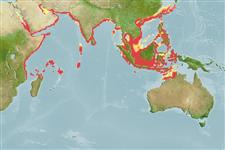Common names from other countries
Environment: milieu / climate zone / depth range / distribution range
Οικολογία
βενθικό(ς); εύρος βάθους 3 - 170 m (Ref. 275). Tropical; 30°N - 15°S, 32°E - 131°E (Ref. 275)
Indo-West Pacific: Indian Ocean, Red Sea and Arabian Sea, eastwards from Mozambique to South China Sea and the Philippine Sea, northward to Taiwan.
Length at first maturity / Μέγεθος / Βάρος / Age
Maturity: Lm 10.0, range 9 - 12.9 cm Max length : 40.0 cm ML αρσενικό/απροσδιόριστο; (Ref. 116232); 23.5 cm ML (female); μεγ. δημοσιευμένο βάρος: 1.5 kg (Ref. 275); μεγ. αναφερόμενη ηλικία: 3.00 έτη (Ref. 275)
Maximum size for female, 23.5 cm, mantle length from Ref. 116229. Minimum depth from Ref. 104457. Neritic, on shallow waters (Refs. 275, 128042). Feeds on fishes, crustaceans and squids (Refs. 275, 104236). Cannibalism is common (Ref. 275).
Members of the class Cephalopoda are gonochoric. Male and female adults usually die shortly after spawning and brooding, respectively. Mating behavior: Males perform various displays to attract potential females for copulation. During copulation, male grasp the female and inserts the hectocotylus into the female's mantle cavity where fertilization usually occurs. Life cycle: Embryos hatch into planktonic stage and live for some time before they grow larger and take up a benthic existence as adults.
Roper, C.F.E., M.J. Sweeney and C.E. Nauen. 1984. (Ref. 275)
IUCN Red List Status (Ref. 130435)
CITES status (Ref. 108899)
Not Evaluated
Not Evaluated
Human uses
αλιεία: Εμπορικό(ά)
| FishSource |
Εργαλεία
Διαδικτυακές πηγές
Estimates based on models
Preferred temperature
(Ref.
115969): 22.9 - 28.6, mean 27.4 (based on 961 cells).
Ελαστικότητα
Υψηλό, ελάχιστος χρόνος για διπλασιασμό πληθυσμού < 15 μήνες (K=0.3-2.25; tm=1; tmax=3).
Vulnerability
Low vulnerability (14 of 100).
